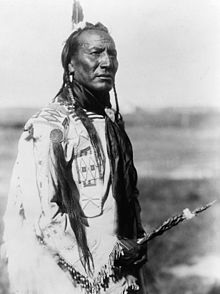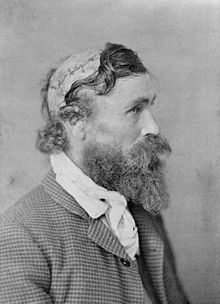Scalping: Difference between revisions
No edit summary |
|||
| Line 13: | Line 13: | ||
[[Image:Robert McGee, scalped as a child by Sioux Chief Little Turtle in 1864.jpg|thumb|right|Robert McGee, scalped as a teenager by [[Sioux]] Chief [[Little Turtle (Sioux)|Little Turtle]], in 1864. {1890} photograph]] |
[[Image:Robert McGee, scalped as a child by Sioux Chief Little Turtle in 1864.jpg|thumb|right|Robert McGee, scalped as a teenager by [[Sioux]] Chief [[Little Turtle (Sioux)|Little Turtle]], in 1864. {1890} photograph]] |
||
[[Image:Scalped Morrison.jpg|thumb|left|Buffalo Hunter Ralph Morrison who was killed and scalped December 7, 1868 near Fort Dodge Kansas by Cheyennes. A Lt Read of the 3rd Infantry and John O. Austin in background. Photograph by William S. Soule]] |
[[Image:Scalped Morrison.jpg|thumb|left|Buffalo Hunter Ralph Morrison who was killed and scalped December 7, 1868 near Fort Dodge Kansas by Cheyennes. A Lt Read of the 3rd Infantry and John O. Austin in background. Photograph by William S. Soule. An Original print and Story can be found here at <ref>[[http://www.photographymuseum.com/soulelg.html]]</ref>]]]] |
||
According to [[ethnohistorian]] [[James Axtell]], there is abundant evidence that the Native American practice of scalping existed long before Europeans arrived. Axtell argues that there is no evidence that the early European explorers and settlers who came to [[the Americas]] were familiar with the ancient European practice of scalping, or that they ever taught scalping to Native Americans. Axtell writes that the idea that Europeans taught scalping to Native Americans became popular recently, during the 1960s. This idea quickly became [[conventional wisdom]] because it fit the tenor of the times of the counter-cultural 1960s, writes Axtell, but he argues that archaeological, historical, pictorial, and linguistic evidence contradicts this notion. Certain tribes of [[Native Americans in the United States|Native Americans]] practiced scalping, in some instances up until the 19th century. |
According to [[ethnohistorian]] [[James Axtell]], there is abundant evidence that the Native American practice of scalping existed long before Europeans arrived. Axtell argues that there is no evidence that the early European explorers and settlers who came to [[the Americas]] were familiar with the ancient European practice of scalping, or that they ever taught scalping to Native Americans. Axtell writes that the idea that Europeans taught scalping to Native Americans became popular recently, during the 1960s. This idea quickly became [[conventional wisdom]] because it fit the tenor of the times of the counter-cultural 1960s, writes Axtell, but he argues that archaeological, historical, pictorial, and linguistic evidence contradicts this notion. Certain tribes of [[Native Americans in the United States|Native Americans]] practiced scalping, in some instances up until the 19th century. |
||
Revision as of 01:56, 27 November 2008
This article has an unclear citation style. |

Scalping is the act of removing the scalp, usually with the hair, as a portable proof or trophy of prowess in war. Scalping is also associated with frontier warfare in North America, and was widely practiced by Native Americans, while also being seen from colonists and frontiersmen over centuries of violent conflict.
Scythia
Scalping was practiced by the ancient Scythians of Eurasia. Herodotus, the Greek historian, wrote of the Scythians in 440 BC: "The Scythian soldier scrapes the scalp clean of flesh and softening it by rubbing between the hands, uses it thenceforth as a napkin. The Scyth is proud of these scalps and hangs them from his bridle rein; the greater the number of such napkins that a man can show, the more highly is he esteemed among them. Many make themselves cloaks by sewing a quantity of these scalps together."
Northern Europe
Scalps were taken in wars between the Visigoths, the Franks and the Anglo-Saxons in the 9th century according to the writings of Abbé Emmanuel H. D. Domenech. His sources included the decalvare of the ancient Germans, the capillos et cutem detrahere of the code of the Visigoths, and the Annals of Flodoard.
North America


]]
According to ethnohistorian James Axtell, there is abundant evidence that the Native American practice of scalping existed long before Europeans arrived. Axtell argues that there is no evidence that the early European explorers and settlers who came to the Americas were familiar with the ancient European practice of scalping, or that they ever taught scalping to Native Americans. Axtell writes that the idea that Europeans taught scalping to Native Americans became popular recently, during the 1960s. This idea quickly became conventional wisdom because it fit the tenor of the times of the counter-cultural 1960s, writes Axtell, but he argues that archaeological, historical, pictorial, and linguistic evidence contradicts this notion. Certain tribes of Native Americans practiced scalping, in some instances up until the 19th century.
The standard Native American technique for scalping was to place a knee between the shoulders while the body was on the ground, to cut a long arc in the front of the scalp, and then to pull back on the hair. If the person survived, the person's facial features drooped. Women would sometimes make a tight braid to pull the skin back up.
Both Native Americans and American frontiersmen frequently scalped their victims in this era. It is believed that contact with Europeans widened the practice of scalping among Native Americans, since some Euro-American governments encouraged the practice among their Native American allies by offering bounties for scalps during times of war.
Examples of the payment for scalps are those issued by the government of Massachusetts in 1744 for the scalps of Indian men, women, and children; Governor Edward Cornwallis' proclamation of 1749 to settlers of Halifax of payment for Indian scalps; and French colonists in 1749 offering payments to Indians for the scalps of British soldiers.

In the Revolutionary War, Henry Hamilton, the British lieutenant-governor of Province of Quebec (1763-1791), was known by American Patriots as the "hair-buyer general" because they believed he encouraged and paid his Native American allies to scalp American settlers. When Hamilton was captured in the war by the colonists, he was treated as a war criminal instead of a prisoner of war because of this. However, American historians have conceded that there was no positive proof that he had ever offered rewards for scalps.[2] It is now assumed that during the American Revolution, no British officer paid for scalps.[3]
Famously, General Custer was not scalped after the Battle of Little Big Horn because he was deemed "a great chief."[4]
In Canada, a 1756 British proclamation issued by Governor Charles Lawrence offering a reward for scalps has yet to be officially repealed.[5]
In popular culture
Blood Meridian, a novel by Cormac McCarthy, is about a group of mercenaries making a living off of Indian scalps, and features the activity extensively.
The 1992 film The Last of the Mohicans features many acts of scalping throughout the film, notably in the battle-scenes between the Native Americans and the European troops.
In the 1994 film Legends of the Fall Tristan Ludlow (Brad Pitt) scalps many German soldiers in the First World War resulting in his discharge from army service.
In the video game Gun, the player is able to scalp dying enemies, after purchasing a special scalping knife.
George Macdonald Fraser's antihero, Harry Flashman, observes scalping and is himself partially scalped in Flashman and the Redskins.
In the 2007 film Saw IV, a woman named Brenda is put into a scalping chair torture device.
See also
Notes
References
- Kelsey, Isabel, Joseph Brant 1743-1807 Man of Two Worlds, 1984, ISBN 0-8156-0182-4
- Axtell, James. "Scalps and Scalping" from Encyclopedia of North American Indians
- Dictionary of Canadian Biography Online: Henry Hamilton
